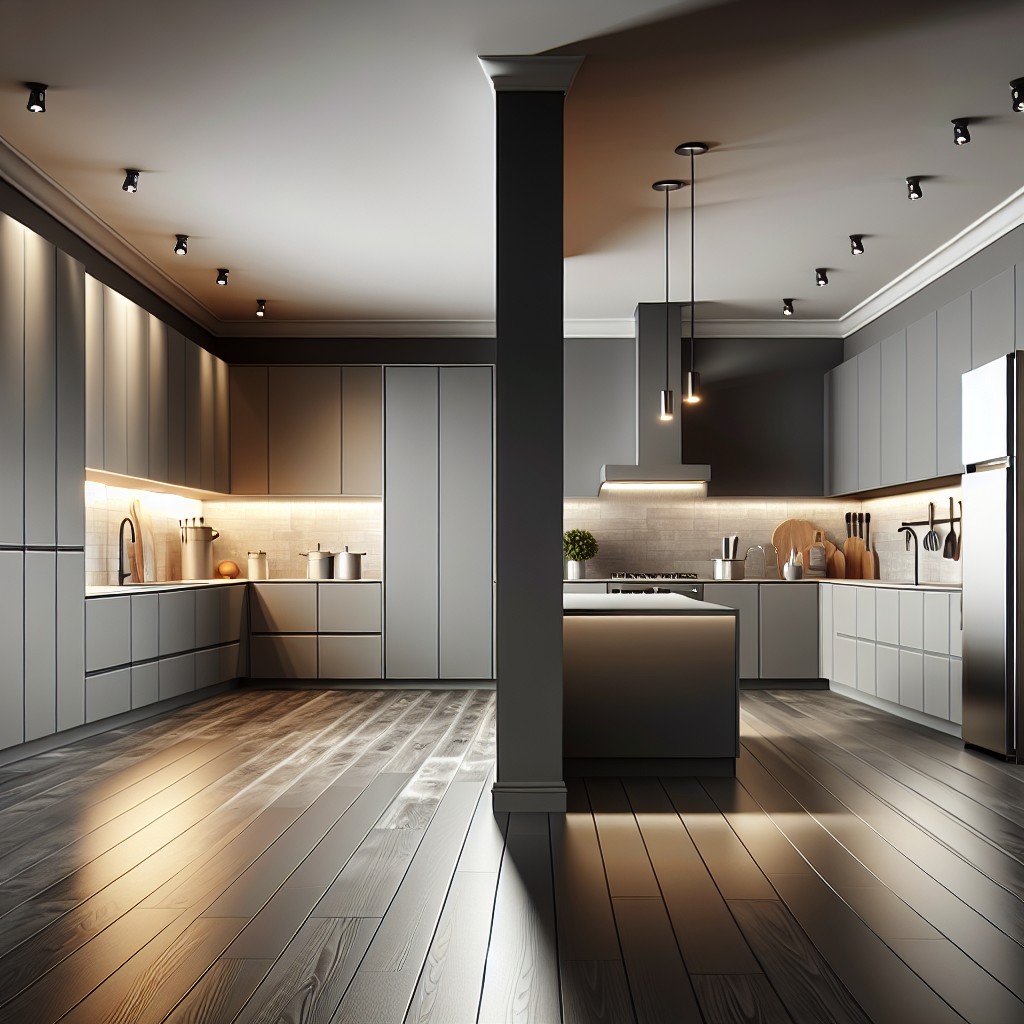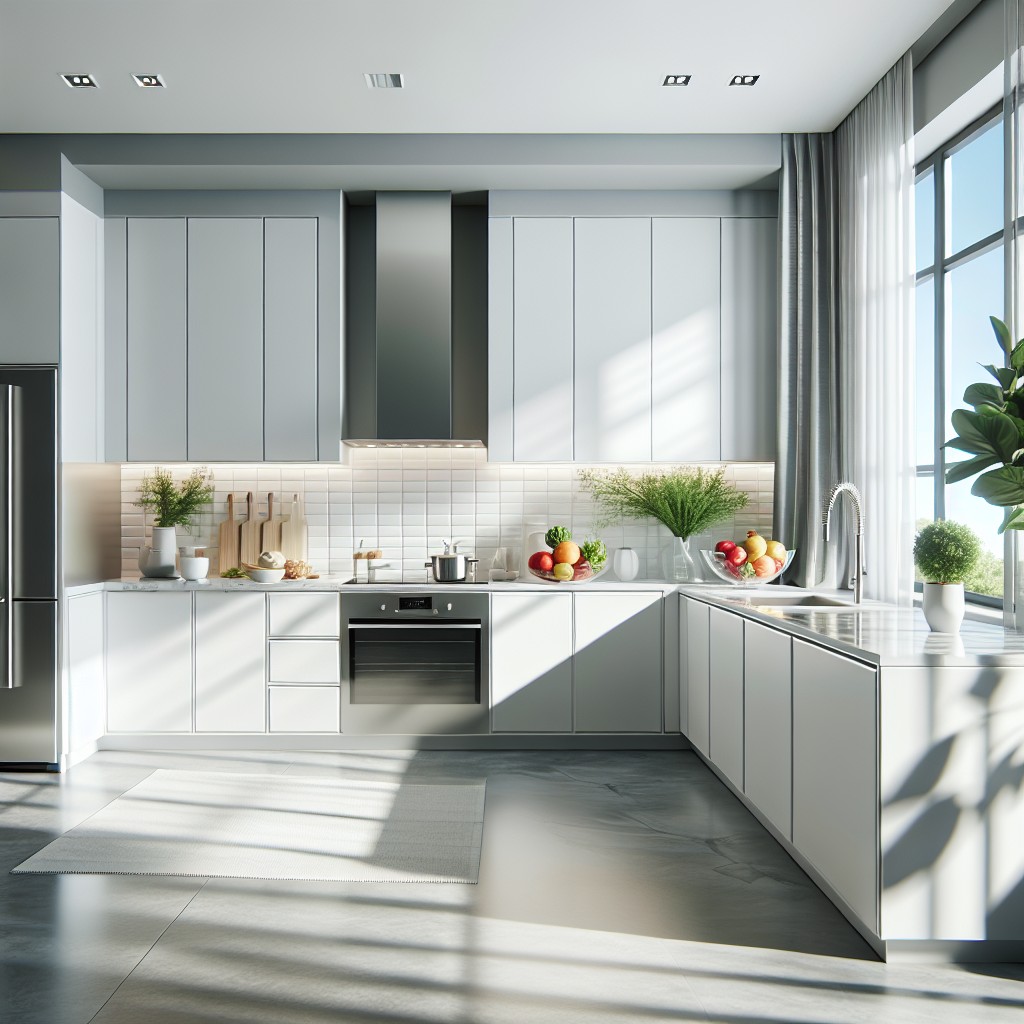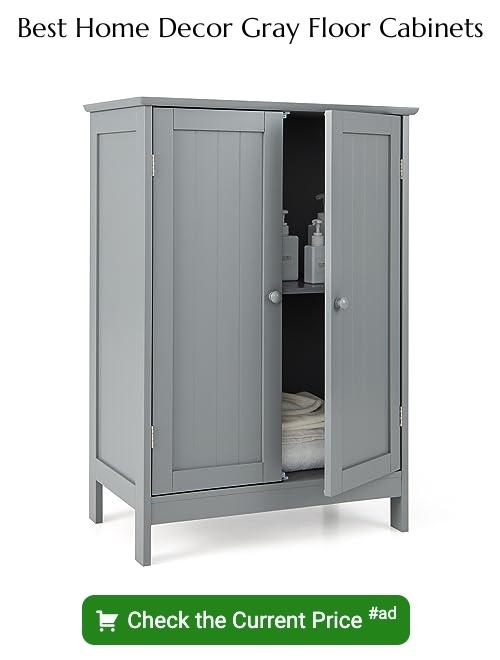Last updated on
Striking the right balance between your cabinet color and gray floors isn’t an easy task, so read on because this post will reveal tried-and-true color combinations that will breathe life into your kitchen design.
Key takeaways:
- Identify the undertone of your gray floor before selecting cabinet colors.
- Warm gray floors pair well with warm wood tones, cream, or beige cabinets.
- Cool gray floors pair well with crisp white, stark black, or cool shades of blue or green cabinets.
- White cabinets are a timeless choice that complement gray floors.
- Experiment with various shades of gray cabinets for a sophisticated look.
What's Inside
Warm Grey Vs. Cool Grey Floors: Understanding Undertones

Identifying the undertone of your grey floor is crucial before selecting cabinet colors. Warm grey floors have a yellow, red, or brown base, creating a cozy and inviting atmosphere. They pair well with warm wood tones, cream, or beige cabinets for a harmonious look.
Conversely, cool grey floors exhibit blue, green, or purple undertones and offer a sleek, modern aesthetic. To complement them, choose cabinets in crisp white, stark black, or cool shades of blue or green. Balancing your cabinet colors with the floor’s undertones ensures a cohesive kitchen design that feels intentional and pleasing to the eye.
Best Kitchen Cabinet Colors for Grey Floors

Selecting the right cabinet colors can significantly enhance the aesthetics of your kitchen with gray floors. For a timeless look, white cabinets are a fail-safe choice, promoting a clean, bright setting that reflects light beautifully. They also offer a stark, appealing contrast against gray flooring.
If you’re inclined towards a more uniform palette, consider gray cabinets that either match or are a few shades lighter or darker than your flooring. This can create a seamless, sophisticated vibe.
For a warm and inviting kitchen, wooden tones from honey to deep espresso add a natural element that complements gray floors well.
Don’t be afraid to make a statement with colors like navy blue or emerald green, which can introduce a vibrant yet elegant contrast to the more neutral gray of the flooring.
Finally, adding pops of color with your accessories can balance out more subdued cabinetry and flooring choices, bringing the room to life.
Cabinet Color Option: Classic White
White cabinets are a timeless choice that bring brightness and a sense of cleanliness to any kitchen space. When paired with gray floors, they create a classic contrast that’s both visually striking and infinitely versatile. Here’s why this combination works well:
- Light Reflection: White surfaces reflect more light than darker shades, enhancing the brightness of a kitchen, which is particularly beneficial in spaces with limited natural light.
- Neutral Backdrop: Acting as a neutral backdrop, white cabinets allow for greater flexibility in introducing accent colors through kitchen accessories, appliances, and wall art.
- Small Space Solution: In smaller kitchens, white can help create the illusion of a larger, more open space, making the room feel less cramped.
- Endless Style Options: Whether your taste veers towards sleek modernity or cozy traditional, white cabinets easily adapt to different design styles and trends.
- Resale Value: White kitchen cabinets appeal to a wide range of prospective homebuyers, potentially increasing the home’s resale value.
Choosing the right shade of white is key—opt for a white that complements the specific undertone of your gray floor to ensure a harmonious look.
Cabinet Color Option: A Mix of Grays
Experimenting with various gray shades adds a sophisticated and dynamic feel to your kitchen. A lighter gray on upper cabinets, paired with a darker tone on lower cabinets, can create a pleasant contrast that visually expands your space.
This approach maintains a monochromatic palette while preventing a flat, uniform look. Utilize contrasting hardware to introduce subtle variations—think matte black handles against light gray doors or brushed nickel against a charcoal base.
For continuity, ensure that all grays share the same undertone, whether warm or cool. This strategy lets you play with depth and interest without straying from the cohesive gray theme on your flooring.
Wood Cabinets: Embracing Natural Tones and Textures
Opting for wood cabinets alongside gray floors offers a welcoming contrast that capitalizes on nature’s palette and texture. Here’s how to nail the look:
- Choose lighter woods like maple or birch to keep the kitchen airy, especially if the gray on the floor leans towards the darker spectrum.
- Consider mid-tone woods such as oak or hickory to bring warmth and a touch of rustic charm without overpowering the space.
- Go with open or glass-front cabinets to showcase the natural beauty of wood grains and knots, adding depth and interest to your kitchen’s aesthetic.
- Enhance the organic feel with matte-finished hardware in black or oil-rubbed bronze for a modern farmhouse vibe.
- Maintain balance by coordinating wood stains with the warmth or coolness of your gray floors, ensuring a cohesive and harmonious design.
Accentuating With Dark Accents
Incorporating dark cabinet shades adds depth to a kitchen with gray flooring. Charcoal, deep blue, or black cabinets not only create a visually striking contrast but also conceal wear and tear better than lighter colors.
For a less dramatic effect, consider using these darker cabinets for lower units or a kitchen island, while maintaining brighter upper cabinets to keep the space open and airy.
Metallic finishes on hardware – think brushed nickel or copper – help to break up the darkness and add a touch of sophistication.
If a solid dark hue feels too bold, explore cabinets with dark wood stains that reveal underlying grain patterns, adding texture and warmth to the space.
Pairs Well: White Cabinets With Gray Undertones
Matching white cabinets that feature a hint of gray creates a seamless blend with gray flooring. This subtle nod to the floor’s color scheme allows for a sleek and modern aesthetic. It’s a delicate balance that ensures your cabinetry doesn’t appear stark or too clinical against the cool backdrop of the floor.
This pairing works particularly well in spaces with ample natural light, where the interplay between light and shadow can accentuate the understated gray undertones. Choosing hardware in brushed nickel or stainless steel can further tie the look together, ensuring a cohesive and stylish kitchen design.
Soft and Subtle: Light Gray-Blue Cabinets
Evoke a sense of calm and serenity in your kitchen by selecting light gray-blue cabinets to complement your gray floors. This choice brings a soft, coastal vibe that’s both refreshing and contemporary.
Here’s what to consider:
- Balance: Ensure a balanced color palette by pairing cabinets with a similar cool undertone as your gray flooring.
- Harmony: This shade works well with stainless steel appliances and brushed nickel hardware, creating a seamless look.
- Contrast: For a bit of contrast, incorporate white countertops or a backsplash, which will prevent the space from feeling monochromatic.
- Lighting: Pay attention to your kitchen’s natural lighting – gray-blue hues can look quite different in varying light conditions, so test samples at different times of the day.
- Accessories: Finish off the design by adding accessories in warm woods or vibrant colors to enliven the space without overwhelming it.
Opting for light gray-blue cabinetry ultimately infuses your kitchen with a gentle, inviting atmosphere that’s both stylish and timeless.
Bold and Soothing: Turquoise Cabinets
For a stunning contrast that teems with vibrancy, consider the unique pairing of turquoise cabinetry against the neutrality of gray floors.
The cool tones in both the floor and the turquoise create a coherent aesthetic while allowing the cabinets to stand as a statement piece. This combination works exceptionally well in spaces with ample natural light, where sunlight can enhance the depth and brightness of the turquoise hue.
When choosing your shade of turquoise, think about the mood you want to set: lighter turquoise brings a cheerful, beachy vibe, while deeper shades can add a touch of sophisticated drama. To avoid overwhelming the space, complement the bold cabinets with minimalistic hardware in matte finishes like brushed nickel or black.
Accessorize with natural elements like wooden bowls or stone countertops to maintain an organic feel. Incorporating neutrals, such as sandy beige or warm white in your backsplash or countertops, can help balance the energy of turquoise and ensure that your kitchen remains a relaxing space. If you’re feeling adventurous, accent with metallics such as copper for a touch of luxury. Remember, the key is to create harmony and let these striking cabinets shine in your kitchen’s composition.
Elegant and Earthy: Olive Green Cabinets
Olive green cabinets create a unique harmony with gray floors, offering a grounding, nature-inspired aesthetic. The earthy tones of olive impart a sophisticated and inviting vibe to the kitchen, while also serving as a versatile base for either a rustic or modern design theme.
Here’s how they enhance the space:
- Blurs the lines between indoors and outdoors, encouraging a calm, natural atmosphere in your kitchen.
- Pairs exceptionally well with metallic accents like brass or copper hardware, adding a touch of luxury without overwhelming the senses.
- Acts as a subtle pop of color that is both unconventional and understated, allowing for creative freedom with decorative elements.
- When combined with natural light, the color deepens, showcasing the dynamic texture and adding visual interest to the space.
- Complements both light and dark gray flooring, ensuring a cohesive look that is adaptable to various lighting conditions throughout the day.
Consider incorporating accessories in terracotta or sandy hues for a complete earth-toned palette that enhances the olive cabinetry.
Chic Combinations: Green and Gold Cabinets
Integrating green cabinets with gold hardware instantly elevates a kitchen’s aesthetic, infusing a sense of luxury against the neutrality of gray floors. The richness of emerald or forest green paired with the shimmer of gold creates an opulent feel without overpowering the space.
Soft sage or mint greens bring in a light and airy ambiance, especially with brushed gold for a more understated elegance.
For a harmonious balance, consider matte or satin finishes on the hardware if the gray flooring has a glossy finish. This contrast in textures adds depth and interest to the kitchen. Additionally, gold’s warm tones contrast beautifully against gray’s coolness, making the space inviting.
Remember that gold comes in various shades, from rose to yellow gold, allowing for customization according to personal taste and existing kitchen features. Incorporate gold elements beyond cabinet hardware into light fixtures and faucet finishes for a cohesive look. Gold’s reflective quality also maximizes natural light, an advantage if the kitchen has ample windows or well-placed lighting.
Grey Wood Cabinets: A Cohesive Look
Opting for grey wood cabinets creates a seamless aesthetic that unites the wooden elements with the grey flooring. This choice delicately balances the warmth of wood with the contemporary feel of grey.
Here’s how to achieve that harmonious kitchen design:
- Choose the Right Shade: Match the grey tone of the cabinets with your floors. If your floors are a light grey, go for a similar shade for the cabinets. For dark grey floors, select a cabinet finish that’s only a few shades lighter to maintain cohesion.
- Play with Textures: A distressed or grainy finish on the cabinets adds depth and interest, preventing a monochromatic look from becoming flat.
- Consider Metal Hardware: Select metallic hardware in brushed nickel or chrome to tie in with the grey theme and add a touch of sophistication.
- Accent with Colors: While maintaining a grey palette, introduce subtle pops of color through accessories or a backsplash to add vibrancy without overpowering the grey-on-grey harmony.
Remember, the goal is to ensure visual flow and warmth, balancing grey’s coolness with the inviting texture of wood.
Are Grey Kitchen Floors in Style?
Grey kitchen floors have shown remarkable staying power in home design trends. They offer a versatile backdrop for any cabinet color, blending with various styles from modern to farmhouse.
These floors also disguise dirt and spills better than lighter shades, making them practical for high-traffic areas. With their neutral tone, they allow for greater creativity in choosing accent colors and kitchen decor, ensuring your kitchen design remains current and fresh.
The vast range of grey shades available means there’s a grey for every preference, whether you’re aiming for a soft, subtle look or something bold and dramatic. Plus, the color’s adaptability means it can easily accommodate future updates to your kitchen aesthetics without the need for a complete overhaul.
Choosing Wall Colors to Complement Grey Flooring
Selecting the ideal wall color can enhance the aesthetic appeal of grey flooring, creating a harmonious and inviting space. Here are some considerations to guide your choice:
- Light neutrals: For a bright and spacious feel, opt for light beige, soft white, or pale taupe. These shades reflect light, contributing to a fresh ambiance.
- Blues and greens: To introduce a calming vibe, contemplate soft blues or gentle greens. These hues pair beautifully with the coolness of grey floors.
- Warm it up: Counterbalance cooler grey tones with warm wall colors like peach, creamy yellow, or even a muted terracotta to add coziness.
- Monochromatic magic: For an ultra-modern, sophisticated look, different shades of grey on walls can work wonders, from light to charcoal.
Incorporating these color strategies results in a cohesive and stylish kitchen environment that complements your grey flooring effortlessly.
Best Grey Kitchen Flooring Material Options
When selecting materials for grey kitchen flooring, durability and maintenance should guide your decision. Here are some top picks:
- Porcelain and Ceramic Tiles: Both offer a wide range of grey shades and are known for their resilience and easy cleaning.
- Luxury Vinyl Plank (LVP): This mimics hardwood but provides better moisture resistance, making it suitable for kitchens.
- Laminate Flooring: An affordable option that replicates the look of wood or stone, providing a grey flooring solution that is easy to install and maintain.
- Polished Concrete: This industrial-chic option delivers a modern look with its sleek grey tones and is exceptionally hard-wearing.
- Natural Stone: Options like slate and limestone bring unique textures and a range of grey variations, ideal for a sophisticated aesthetic, though they may require more upkeep.
Each flooring type has its own benefits and distinctive look, ensuring there’s a grey floor to suit every kitchen style and functional requirement.
FAQ
What color combination goes with grey flooring?
Grey flooring pairs best with wall colors such as navy, dusty blue, white, green, gray, orange, pink, and yellow.
What color cabinets go with grey?
The bright color of white cabinets pairs excellently with grey walls, offering a neat contrast that can illuminate the space.
Should kitchen cabinets and floor be the same color?
Kitchen cabinets and floors do not have to be the same color; in fact, interior design experts recommend mixing complementing materials for a more visually appealing look.
How do different wood tones interact with gray flooring?
Different wood tones can either contrast against or complement gray flooring depending on their warmth, with warmer hued woods offering a striking contrast, while cooler toned woods harmonize effectively.
What are the best wall colors to complement gray flooring and colored cabinets?
For gray flooring and colored cabinets, consider wall colors such as hues of blue, white, warm-toned neutral colors, or pastel shades.
How can you incorporate metal finishes in a kitchen with gray floors and colored cabinets?
Incorporating metal finishes in a kitchen with gray floors and colored cabinets can be accomplished by utilizing stainless steel appliances, introducing metallic accessories like brushed nickel knobs or brass lighting fixtures that coordinate with the cabinet color, and considering the use of a metallic backsplash for more visual appeal.





